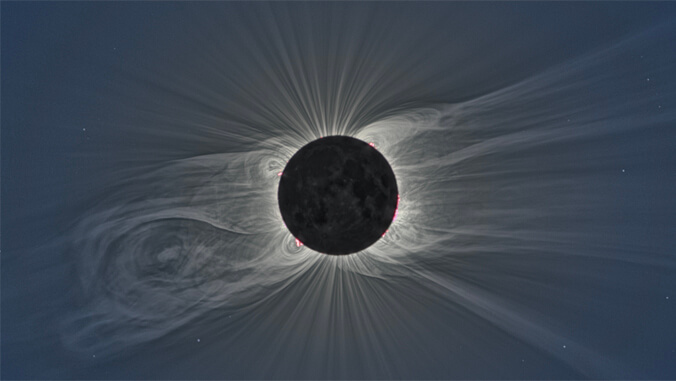
A new study by Institute for Astronomy (IfA) astronomers at the University of Hawaiʻi investigates a unique solar magnetic eruption observed during the 2020 total solar eclipse from Argentina. The team found that a Coronal Mass Ejection (CME) had occurred serendipitously during the brief time that the Moon blocked out the Sun over South America, which is analyzed in the new study in the Astrophysical Journal Letters.
“CMEs are the most violent events on the Sun that throw out a large amount of material into the solar system,” said IfA astronomer Benjamin Boe, the lead author on the study. “Sometimes CMEs impact the Earth and will cause bright aurora, also called the northern and southern lights. Particularly large CMEs can cause blackouts and issues with technology on the ground. Future astronauts traveling to the Moon and Mars will also need to beware of CMEs.”
The largest CME ever recorded is known as the “Carrington Event,” named after the astronomer who observed it on the Sun. In 1869, the intense solar eruption hit Earth and produced aurora as far south as Hawaiʻi.
The Carrington CME also had a massive impact on the technology of the time, causing immense damage to telegraph systems—whose long wires stretching across continents acted as giant antennas for the CME’s magnetic energy. Such an event today would devastate the world’s power grid, so fully understanding the nature of these events is a crucial endeavor.
Almost every single day, a large magnetic eruption or CME occurs on the Sun’s surface. The Sun also emits a comparatively steady and quiet outflow of material known as the solar wind. This stream of charged particles released from the upper atmosphere of the Sun can be thought of like Earth’s daily weather, while CMEs are like powerful hurricanes.
Surveying the Sun’s surface
There are many ways to study the solar corona, from spacecraft, to ground-based solar telescopes, but solar eclipses provide a superior opportunity. Even amateur data from consumer-grade cameras can produce scientifically useful imaging.
Boe, IfA astronomer Shadia Rifai Habbal and IfA graduate student Bryan Yamashiro were part of a team that studied white-light imaging of the eclipse. The images were taken at two different sites spread out over the path of totality, enabling the measurement of changes in the corona, the outermost part of the Sun’s atmosphere, over a period of several minutes. During that time, the observed CME was moving through the corona.
“An amateur observer, Dario Harari, contacted me on social media asking for tips on how to correctly observe the eclipse,” said Boe, “I trained them via email how to collect the best possible data with their camera setup. They ended up gathering some really nice images that we were able to use.”
The eclipse images revealed some unique dynamics for this particular eclipse, specifically that neighboring regions on the Sun interacted during the early phase of the CME eruption to create an interesting “double-bubble” shape in the corona.
The CME originated inside of an active region, the most magnetically active regions on the Sun which create sunspots, but it also interacted with a nearby prominence—a region of elevated cool plasma which often generate CMEs.
“This study, along with other recent work, is pointing to larger-scale interactions between somewhat distant regions of the corona,” said Boe. “However, never before have interactions between prominences and active regions been reported in this fashion.”
This work illuminates a new class of phenomenon that can alter the nature of CME evolution as they pass through the corona on their journey into the solar system, adding a new piece of information that will expand our understanding of these events and improve our ability to predict their dynamics and evolution.
- Related UH News stories:
- Eclipse data illuminate mysteries of Sun’s corona, June 5, 2020
- ‘Eclipse Chaser’ children’s book features UH astronomer, January 21, 2020
This research is an example of UH Mānoa’s goal of Excellence in Research: Advancing the Research and Creative Work Enterprise (PDF), one of four goals identified in the 2015–25 Strategic Plan (PDF), updated in December 2020.

